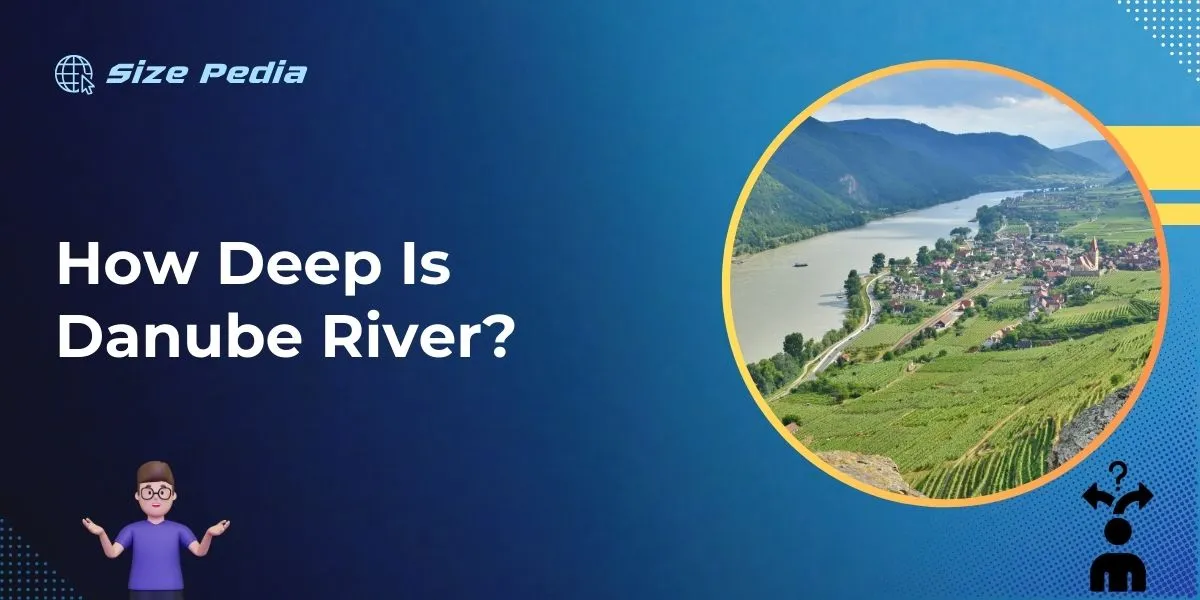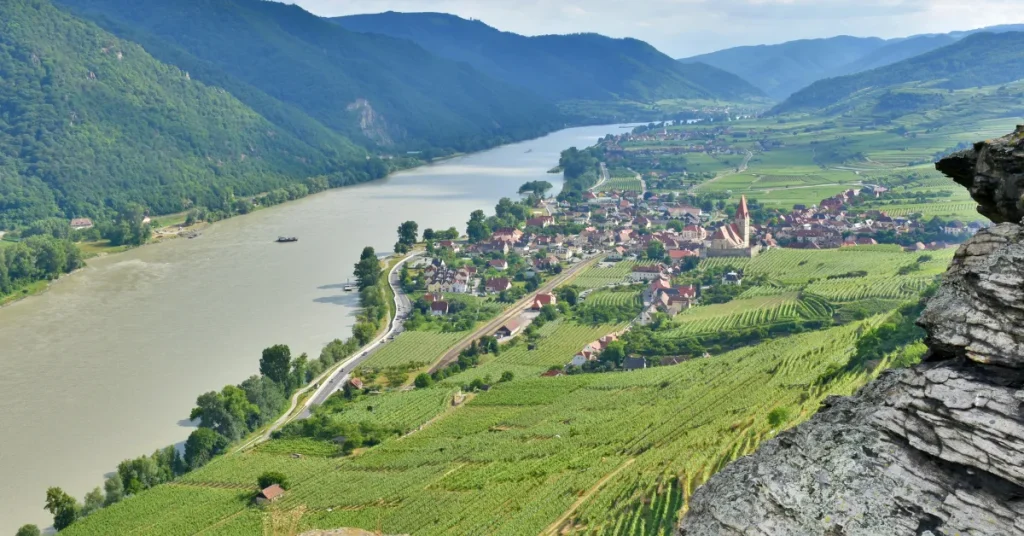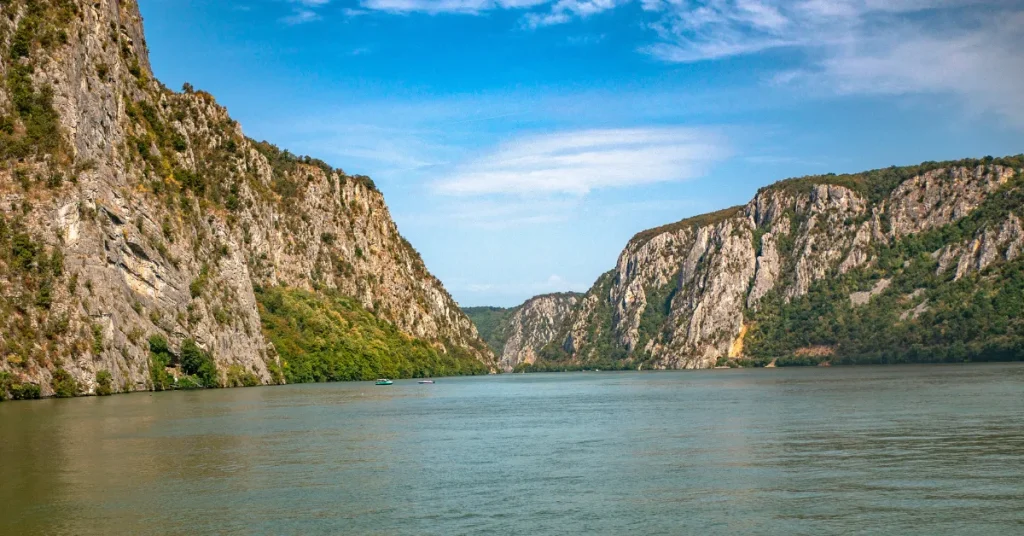The Danube River has an average depth of 6.5 to 7 meters (21 to 23 feet). Its deepest point is approximately 12 meters (39 feet).
The Danube River, one of Europe’s longest rivers, flows through ten countries and serves as a vital waterway for commerce, travel, and ecosystems. Its depth varies significantly, accommodating a variety of marine life and enabling ship navigation.
Tourists flock to its banks to experience its natural beauty and cultural significance, while major cities like Vienna, Budapest, and Belgrade benefit from its resources.
With historical roots dating back to ancient civilizations, the Danube continues to be an emblem of European unity and diversity.
Balancing ecological health with economic interests, the river remains a key focus for conservation efforts as countries along its course collaborate to maintain its vitality for future generations.

Mysteries Beneath The Surface
The Danube River is not only a vital waterway that courses through the heart of Europe but also a silent storyteller. Its waters guard secrets from bygone eras, submerged worlds hidden from sight.
Exploring these mysteries reveals fascinating tales of the past and an ever-changing landscape beneath the surface.
The Varying Depths Of The Danube
The bed of the Danube River shifts like a mysterious, underwater tapestry. Depths vary dramatically as the river snakes from the Black Forest to the Black Sea.
Near its source in Germany, the river is relatively shallow; travelers can sometimes cross without wetting their knees.
As it continues its journey, the riverbed plunges into profound depths, creating natural habitats for aquatic species. In these dark, unseen regions, the river can reach downwards over two hundred feet!
- Source in Germany: < 3 feet (0.9 meters)
- Budapest, Hungary: 15 – 20 feet (4.5 – 6 meters)
- Iron Gates Gorge: Up to 282 feet (86 meters)
Historical Significance Of The River’s Depths
The depths of the Danube have shaped human history. Along its banks, ancient civilizations traded and traveled, making it a crucial artery of commerce.
The deep sections were strategic points for ancient forts, as controlling these depths meant dominating trade routes.
Beneath the surface, shipwrecks from World War conflicts lie undisturbed, serving as underwater museums of history. Artifacts and remnants of past lives tell stories of the river’s role in shaping cultures and nations.
| Location | Significance |
| Iron Gates Gorge | The river’s greatest depth, a vital trade route passage |
| Vienna Basin | Known for its rich archeological sites submerged under shallow depths |
Discovering the depths of the Danube is an adventure into the unknown, where every fathom unfurls tales from the depths of time.
The river’s mysterious bed holds keys to historical events, scenic byways, and an ecosystem teeming with life—a continuous reminder of the ebb and flow of human existence.
Navigating The Hidden Trenches
The Danube River flows like a winding adventure story through Europe. It carries secrets beneath its ripples, including its hidden depths.
Some call it the heart of the river, a place where ancient currents have carved out deep halls in its bed. Navigating these parts requires skill and knowledge, as the invisible underwater terrain can turn a peaceful journey into a challenging mission.
Sailors honor these secretive spots with respect, while explorers seek to unlock their mysteries.
Challenges Posed By The Danube’s Deepest Points
- Varying water levels: Throughout the seasons, water levels change, making shallow areas treacherous and deepest points unpredictable.
- Undercurrents and whirlpools: The flow at these points can be powerful, affecting navigation.
- Debris accumulation: The deepest parts can harbor debris, which could damage vessels.
Mapping The Depths For Safe Passage
Modern technology allows precise mapping of the underwater landscape. Experts use:
- Sonar: Sends sound waves to measure depth.
- Satellite imagery: Provides a broader view of the waterway.
- Submersibles: Explore the trenches up close.
Charts guide captains and prevent mishaps. Authorities keep them updated for safety. As a result, the Danube continues to be a lifeline for commerce, and a symbol of natural wonder.
The Danube’s Depths As Ecosystems

The lifeblood of Central and Eastern Europe, the Danube River is more than just a body of water. It’s a crucial ecosystem, bustling with life and nourishing the regions it flows through.
At various points, the Danube’s depths reveal a world often unseen but integral to the river’s health and biodiversity.
Marine Life In The Danube’s Deepest Stretches
Dive into the hidden layers of the Danube, and you’ll find a vibrant tapestry of marine life. Each species has adapted to thrive in the specific conditions that the river’s depths provide.
Consider the surprise of finding sturgeons, historic and massive fish, in the twilight zone of the Danube.
- Catfish: Lurking in deep pockets
- Pike: Gliding through shadowy layers
- Mussels: Clinging to the riverbed
Impact Of Depth On River Biodiversity
The depth of the Danube plays a pivotal role in the diversity of species it supports. With each gradient in depth, a new niche is carved out, home to lifeforms specialising in that very strata.
The deeper areas tend to be cooler and less turbulent, offering a sanctuary for certain types of fish and plant life.
| Depth (meters) | Temperature Range (°C) | Ecosystem Impact |
| 0-10 | 4-20 | High light, diverse species |
| 10-20 | 6-18 | Diminished light, specialised species |
Treasure And Tales Submerged
The Danube River, Europe’s second-longest river, holds secrets beneath its depths. Over centuries, the Danube has witnessed countless tales and amassed treasures along its bed.
History enthusiasts and curious minds find themselves drawn to the mysteries submerged within its waters. Let’s take a plunge into the treasures and tales hidden beneath the Danube’s surface.
Archaeological Finds Beneath The Waves
For archaeologists, the Danube riverbed is like a vast, waterlogged treasure chest. Artifacts dating back to ancient civilizations whisper stories of human history from beneath the waves.
- Well-preserved relics reveal insights into the lives of people who lived by the river.
- Shipwrecks and sunken settlements wait to be explored and understood.
- Roman amphorae, medieval weapons, and long-lost personal items paint a picture of trade and life along the Danube.
Myths And Legends Of Deep Danube Locales
The Danube’s depths are not just the resting place of physical artifacts; they are the cradle for stories that have rippled through time. Village elders and storytellers maintain a rich tapestry of folklore surrounding the river.
- Tales of mythical creatures claims the Danube as their home.
- Bold accounts of hidden riches and sunken castles ignite the imagination.
- Lore of drowned cities and otherworldly realms beneath the river’s flow gives the Danube a mystic aura.
These stories, passed down through generations, fuel the aura of mystery that the Danube proudly carries.
Environmental Concerns And Conservation Efforts
The Danube River, Europe’s second longest river, is not only famous for its beauty and cultural significance but also for its varying depths that create diverse ecosystems.
Environmental concerns are growing due to human activity and climate change, threatening the river’s health and depth. Conservation efforts are crucial to maintain this natural wonder for future generations.
Threats To The Danube’s Deep Regions
Several issues pose risks to the Danube’s depth:
- Pollution from industrial and agricultural sources disrupts water quality.
- Overfishing affects aquatic life that depends on the river’s depth.
- Climate change leads to erratic water levels, influencing depth.
- Damming and dredging alter natural depth patterns, harming habitats.
Initiatives To Protect The River’s Depth Dynamics
Multiple initiatives aim to preserve the Danube’s depths:
- International cooperation, such as the International Commission for the Protection of the Danube River (ICPDR), creates policies for sustainability.
- Habitat restoration projects work to reinstate the river’s original depth profiles.
- Education and awareness campaigns highlight the importance of depth diversity.
- Efforts to reduce pollutants and improve water management protect the river’s natural state.
Working together, governments, organizations, and individuals can ensure the river remains a deep, dynamic habitat for a myriad of species.
Future Explorations And Research

Exploring the depths of the Danube River unlocks mysteries of aquatic biodiversity and historical waterways. Future research endeavors aim to delve into its undercurrents, shedding light on ecological systems and promoting conservation.
The Danube River, veiled in mystery, beckons researchers to delve deeper into its depths. Future explorations and research possess the promise of unraveling the river’s esoteric tales.
With the Danube winding through varied landscapes, it’s imperative to forge ahead in understanding its dynamic ecosystem and hidden secrets.
Advancements In Underwater Technology
New technologies propel us into the unseen realms of the Danube. Divers equipped with state-of-the-art gear will navigate the river’s intricate underwater terrain. Expectations run high as these advancements include:
- Autonomous underwater vehicles (AUVs) for wider exploration
- Remote sensing tools to map the riverbed
- Advanced diving suits enabling deeper dives
These innovations crack open doors to areas once inaccessible, promising thrilling discoveries about the river’s depth and biodiversity.
Emerging Studies On The Danube’s Underwater Secrets
Researchers are on the verge of launching exploratory studies aiming to dissect the Danube’s enigmas. The focus will particularly be on:
- Ancient riverbed settlements and artifacts
- Ecosystem monitoring and species documentation
- Impact assessment of climate change on the Danube
These studies, empowered by cutting-edge tools, hold the potential to stitch together the past and present of Europe’s second-longest river.
FAQs About How Deep Is Danube River
What Is The Maximum Depth Of Danube River?
The Danube River reaches its greatest depth at 230 feet (70 meters) below the surface. This profound depth is found downstream of the Cazane Gorge, where the riverbed narrows and deepens.
How Does Danube River’s Depth Vary?
The depth of the Danube River varies considerably along its course, typically ranging from 7 feet (2 meters) to 46 feet (14 meters) in shallower parts. Depth variations are influenced by natural riverbed formations and water management structures like dams and locks.
Where Is The Danube River Shallowest?
The Danube River is notably shallow in its upper stretches near Donaueschingen, and in the Hungarian plains. There, the river’s depth can reduce to as little as 3 feet (1 meter) during dry seasons or droughts.
Does Danube River Depth Affect Navigation?
Yes, the depth of the Danube River influences navigation, particularly affecting large commercial vessels. Certain stretches require dredging and careful monitoring to maintain a navigable channel, ensuring safe and continuous marine traffic.
Conclusion
Exploring the depth of the Danube River unravels a tapestry of natural wonder and historical significance. With an average depth of 7 meters, this majestic waterway has been a lifeline through Europe for centuries.
As our journey along the Danube ends, keep in mind its variations, shaped by geographical diversity.
Whether for travel, study, or simple curiosity, the river’s depths hold stories awaiting your discovery. Remember, the Danube’s beauty runs as deep as its waters.
Resources:
1. https://earthobservatory.nasa.gov/images/80459/where-the-danube-meets-the-black-sea
